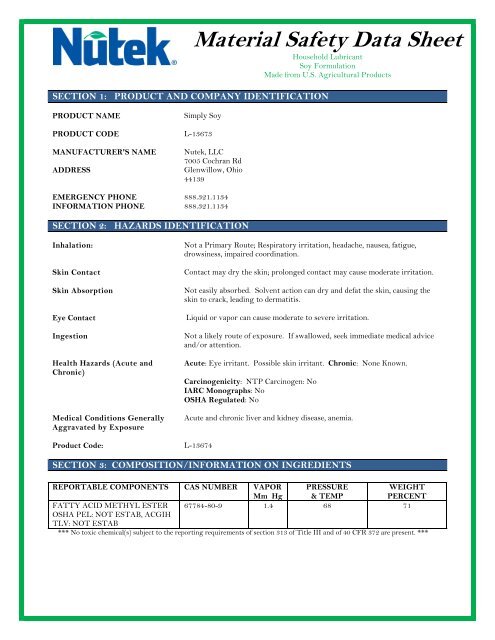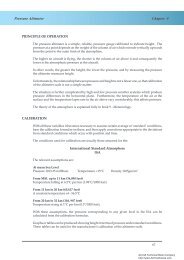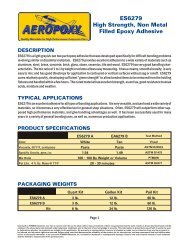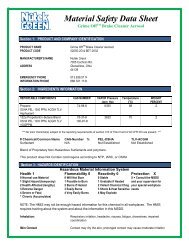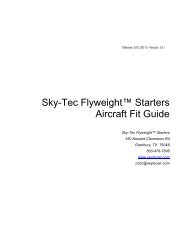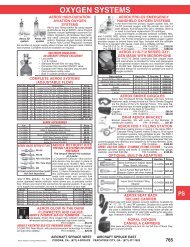Simply Soy MSDS - Aircraft Spruce
Simply Soy MSDS - Aircraft Spruce
Simply Soy MSDS - Aircraft Spruce
Create successful ePaper yourself
Turn your PDF publications into a flip-book with our unique Google optimized e-Paper software.
SECTION 1: PRODUCT AND COMPANY IDENTIFICATION<br />
PRODUCT NAME<br />
<strong>Simply</strong> <strong>Soy</strong><br />
PRODUCT CODE L-13673<br />
MANUFACTURER'S NAME Nutek, LLC<br />
7005 Cochran Rd<br />
ADDRESS Glenwillow, Ohio<br />
44139<br />
EMERGENCY PHONE 888.321.1134<br />
INFORMATION PHONE 888.321.1134<br />
SECTION 2: HAZARDS IDENTIFICATION<br />
Inhalation: Not a Primary Route; Respiratory irritation, headache, nausea, fatigue,<br />
drowsiness, impaired coordination.<br />
Skin Contact Contact may dry the skin; prolonged contact may cause moderate irritation.<br />
Skin Absorption Not easily absorbed. Solvent action can dry and defat the skin, causing the<br />
skin to crack, leading to dermatitis.<br />
Eye Contact Liquid or vapor can cause moderate to severe irritation.<br />
Ingestion Not a likely route of exposure. If swallowed, seek immediate medical advice<br />
and/or attention.<br />
Health Hazards (Acute and<br />
Chronic)<br />
Medical Conditions Generally<br />
Aggravated by Exposure<br />
Product Code: L-13674<br />
Material Safety Data Sheet<br />
Household Lubricant<br />
<strong>Soy</strong> Formulation<br />
Made from U.S. Agricultural Products<br />
Acute: Eye irritant. Possible skin irritant. Chronic: None Known.<br />
Carcinogenicity: NTP Carcinogen: No<br />
IARC Monographs: No<br />
OSHA Regulated: No<br />
Acute and chronic liver and kidney disease, anemia.<br />
SECTION 3: COMPOSITION/INFORMATION ON INGREDIENTS<br />
REPORTABLE COMPONENTS CAS NUMBER VAPOR PRESSURE<br />
WEIGHT<br />
Mm Hg & TEMP<br />
PERCENT<br />
FATTY ACID METHYL ESTER<br />
OSHA PEL: NOT ESTAB, ACGIH<br />
TLV: NOT ESTAB<br />
67784-80-9 1.4 68 71<br />
*** No toxic chemical(s) subject to the reporting requirements of section 313 of Title III and of 40 CFR 372 are present. ***
SECTION 4: FIRST AID MEASURES<br />
Inhalation: Remove to fresh air. Administer oxygen if needed. Apply artificial<br />
respiration if breathing has stopped. Get medical attention.<br />
Skin: Wipe off with towel. Wash with soap and water. Get medical attention if<br />
irritation persists.<br />
Eyes: Wash immediately with large volumes of fresh water for at least 15 minutes.<br />
Get medical attention.<br />
SECTION 5: FIRE FIGHTING MEASURES<br />
FLASH POINT: 425 deg F METHOD USED: PMCC<br />
FLAMMABLE LIMITS IN AIR BY VOLUME- LOWER: None UPPER: None<br />
EXTINGUISHING MEDIA: FOAM, CO2, DRY CHEMICAL, WATER FOG<br />
SPECIAL FIREFIGHTING PROCEDURES<br />
Water spray may be ineffective. Water may be used to cool containers to prevent pressure build-up and explosion<br />
when exposed to extreme heat. If water is used, fog nozzles preferred. Wear goggles and self-contained breathing<br />
apparatus.<br />
UNUSUAL FIRE AND EXPLOSION HAZARDS<br />
Closed containers may explode when exposed to extreme heat. Over-exposure to decomposition products may cause a<br />
health hazard. Symptoms may not be readily apparent. Obtain medical attention.<br />
SECTION 6: ACCIDENTAL RELEASE MEASURES<br />
STEPS TO BE TAKEN IN CASE MATERIAL IS RELEASED OR SPILLED<br />
Avoid breathing vapors. Ventilate area. Remove all sources of ignition. Clean up area with absorbent material and<br />
place in closed containers for disposal.<br />
SECTION 7: HANDLING AND STORAGE<br />
Handling & Storage: STORE AND USE IN COOL, DRY, WELL-VENTILATED AREAS. KEEP<br />
CONTAINERS CLOSED WHEN NOT IN USE. KEEP AWAY FROM<br />
EXCESSIVE HEAT OR OPEN FLAME. VAPORS MAY IGNITE<br />
EXPLOSIVELY. VAPORS MAY SPREAD LONG DISTANCES.<br />
PREVENT BUILD-UP OF VAPORS. EXTINGUISH ALL PILOT<br />
LIGHTS AND TURN OFF HEATERS, NON-EXPLOSION PROOF<br />
ELECTRICAL EQUIPMENT AND IGNITION SOURCES DURING USE.<br />
POSURE CONTROL/PERSONAL PROTECTION<br />
PRECAUTIONS<br />
Use with adequate ventilation. To prevent vapor build-up, open doors and windows or use an explosion-proof<br />
exhaust fan to ensure fresh air exchange during and after use. Do not breathe vapor, gas or spray mist. When using,<br />
do not eat, drink or smoke. Avoid contact with eyes, skin and clothing. Wear protective equipment. Wash<br />
thoroughly after handling. Remove contaminated clothing and wash it before re-use. Empty containers retain<br />
product residue; follow label warnings even after can is emptied. Do not store in basements. Do not take internally.<br />
RESPIRATORY PROTECTION<br />
In restricted areas, use approved chemical/mechanical filters designed to remove a combination of particles and vapor.<br />
In confined areas, use approved air line type respirator or hood. Self-contained breathing apparatus is required for<br />
vapor concentrations above PEL/TLV limits.
VENTILATION<br />
Sufficient to prevent inhalation of solvent vapors. General dilution and/or local exhaust ventilation in volume or<br />
pattern to keep PEL/TLV of most hazardous ingredient below acceptable limit and LEL below stated limit.<br />
PROTECTIVE GLOVES<br />
Solvent resistant gloves required for prolonged or repeated contact.<br />
EYE PROTECTION<br />
Use of safety glasses with splash guards or full face shield is recommended.<br />
OTHER PROTECTIVE CLOTHING OR EQUIPMENT<br />
Use of solvent resistant aprons or other clothing is recommended.<br />
WORK/HYGIENIC PRACTICES<br />
Eye washes and safety showers in the workplace are recommended.<br />
SECTION 9: PHYSICAL AND CHEMICAL PROPERTIES<br />
BOILING RANGE: 600 deg F SPECIFIC GRAVITY (H2O=1): 0.89<br />
VAPOR DENSITY: HEAVIER THAN AIR EVAPORATION RATE: SLOWER THAN ETHER<br />
SOLUBILITY IN WATER: NIL<br />
APPEARANCE AND ODOR: Colorless liquid; typical solvent odor. Saturated cotton wipe.<br />
SECTION 10: STABILITY AND REACTIVITY<br />
STABILITY: Stable<br />
CONDITIONS TO AVOID:<br />
Application to hot surfaces. Storage above 120 Degrees Fahrenheit. Exposure to open flame.<br />
INCOMPATIBILITY (MATERIALS TO AVOID):<br />
Unknown.<br />
HAZARDOUS DECOMPOSITION OR BYPRODUCTS:<br />
May produce fumes when heated to decomposition. Fumes may contain carbon monoxide and other toxic<br />
fumes.<br />
HAZARDOUS POLYMERIZATION:<br />
Will not occur.<br />
SECTION 11: TOXICOLOGICAL INFORMATION<br />
Long-term toxicological studies have not been conducted for this product.<br />
SECTION 12: ECOLOGICAL INFORMATION<br />
Long-term ecological studies have not been conducted for this product.<br />
SECTION 13: DISPOSAL CONSIDERATIONS<br />
Dispose of in accordance with local, state and federal regulations. Before attempting to clean up, refer to other<br />
sections of this <strong>MSDS</strong> for hazard caution information.
SECTION 14: TRANSPORT INFORMATION<br />
By Land: Not Regulated<br />
By Water: Not Regulated<br />
By Air: Not Regulated<br />
SECTION 15: REGULATORY INFORMATION<br />
All ingredients are either listed on the TSCA inventory or are exempt.<br />
SECTION 16: OTHER INFORMATION<br />
DATE PRINTED: 01/21/11 NAME OF PREPARER: RY<br />
HMIS CODES: H-1 F-4 R-0 P-<br />
The information contained herein is based on data considered accurate. However, no warranty is expressed<br />
or implied regarding the accuracy of the data or the results to be obtained from the use thereof. Because the<br />
information contained herein may be applied under conditions beyond our control, we assume no<br />
responsibility for its use.


